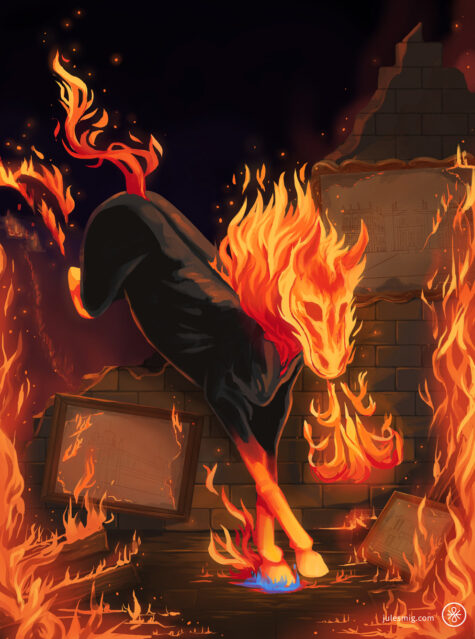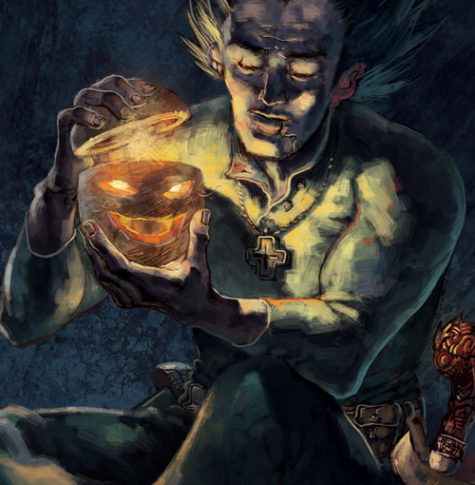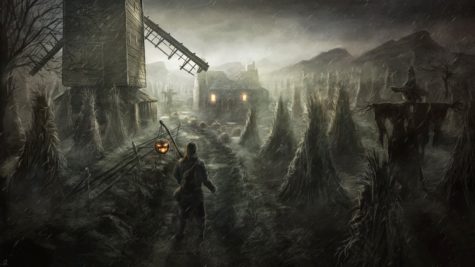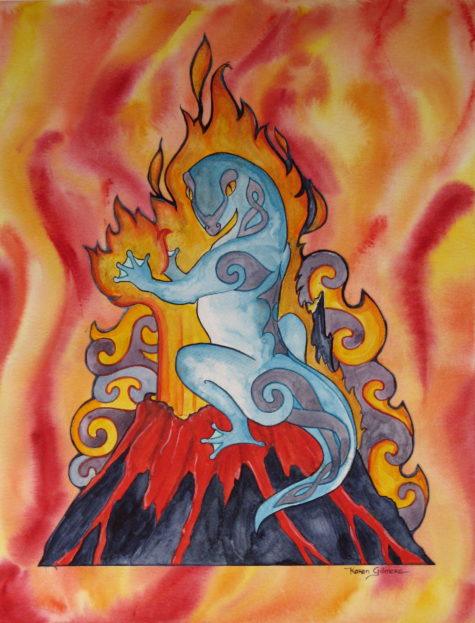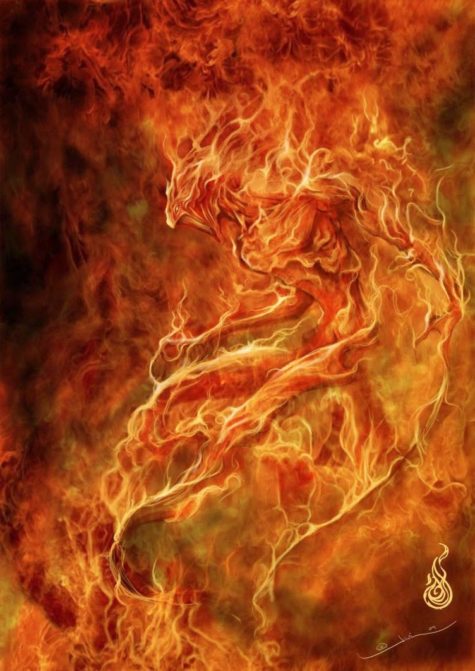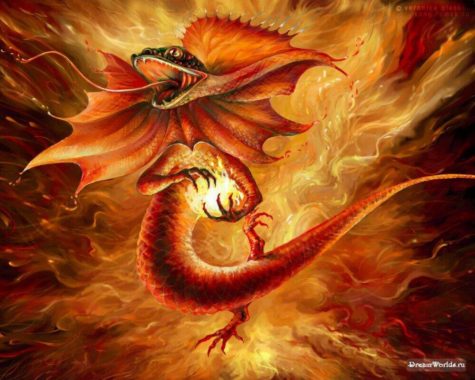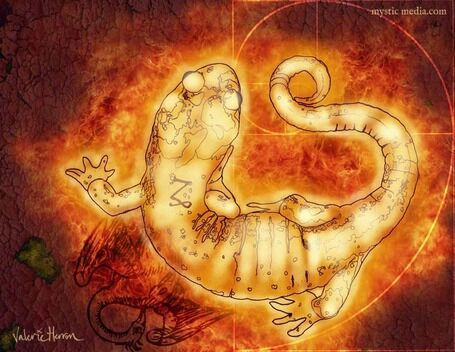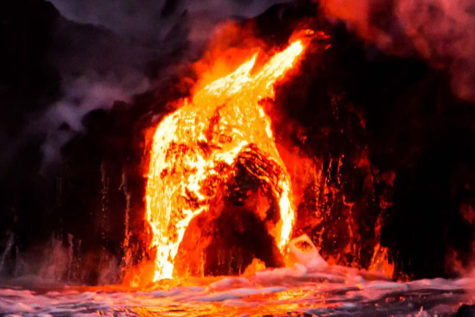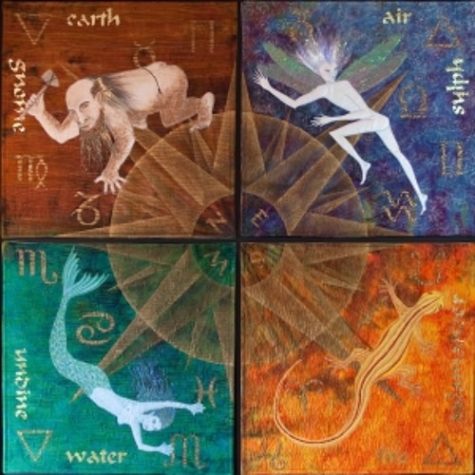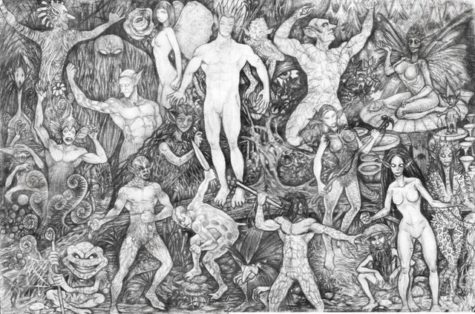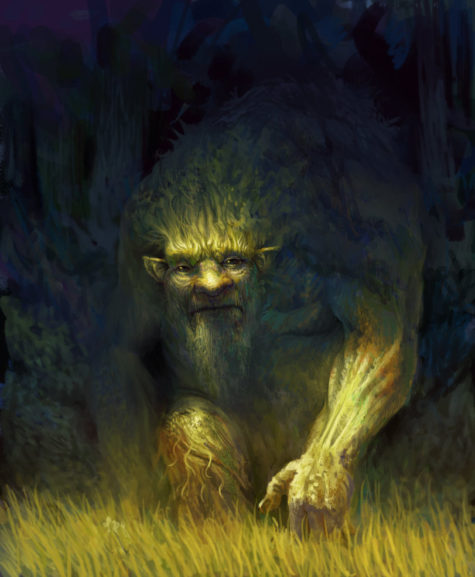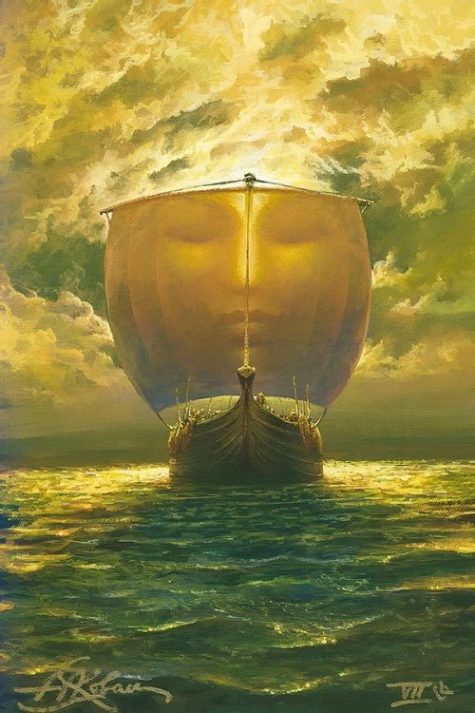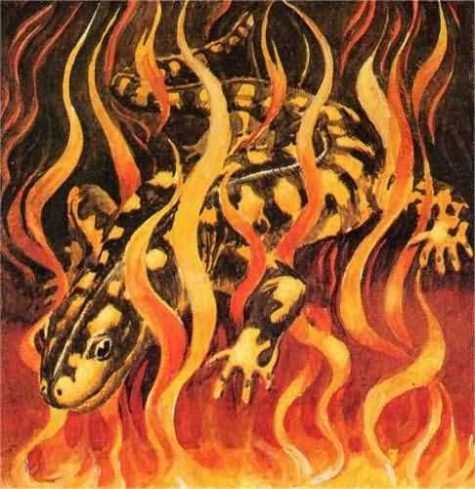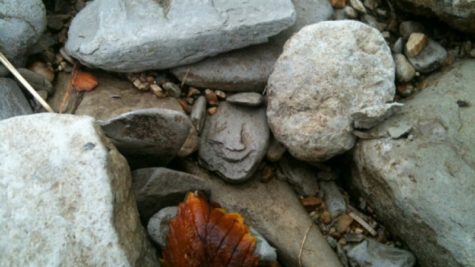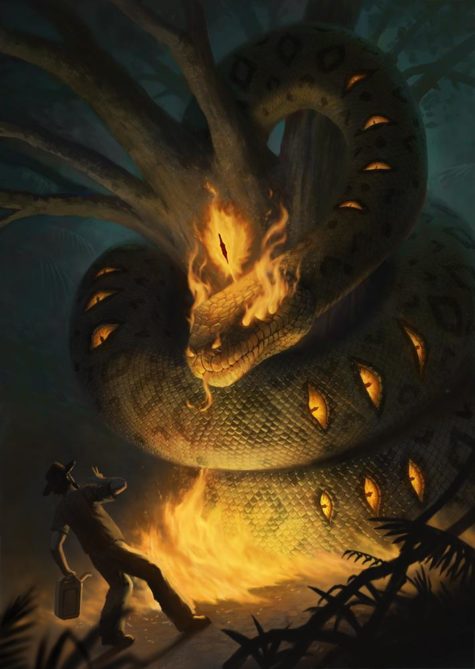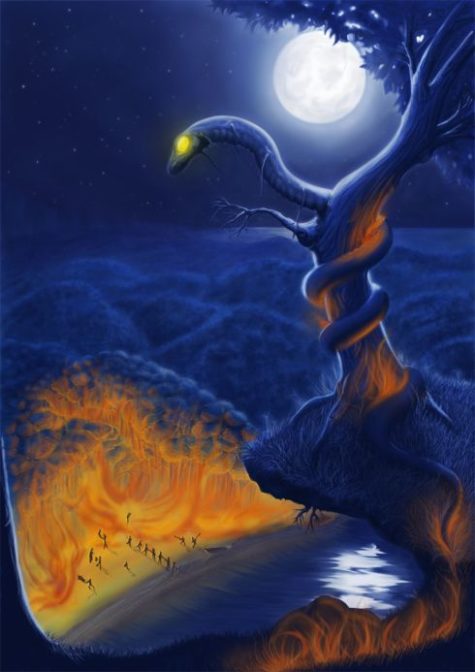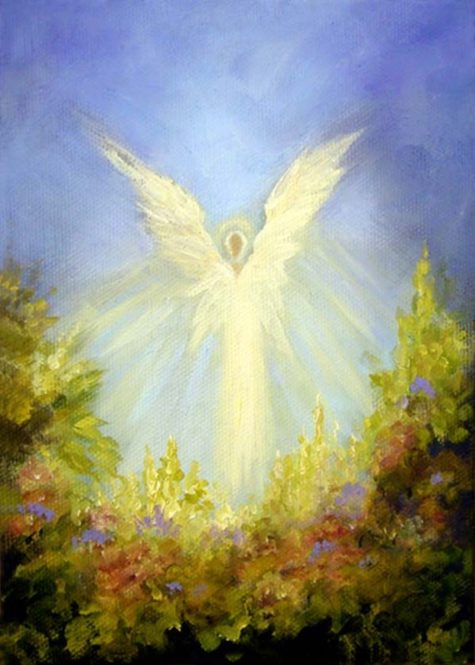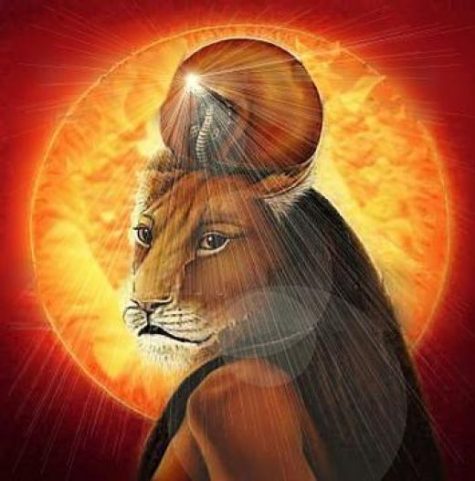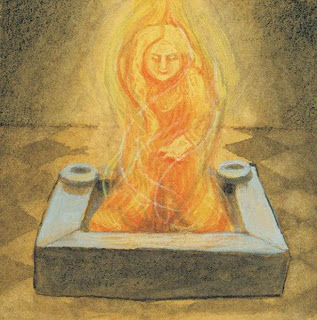Fire
The Headless Mule or Mula-Sem-Cabeça, is a mythical character in Brazilian folklore. The Mule’s appearance varies greatly from region to region. Its color is most commonly given as brown, sometimes as black. It has silver (or iron) horseshoes that produce a hideous trotting sound, louder than any horse is capable of producing.
The legend of the mula tells of a girl or woman who was cursed for having relations with a priest. As punishment for her part in a man of God’s sin, she is condemned to transform into a wild mule with fire in place of a head, shooting flames from its nonexistent nostrils and stampeding through villages at night. In the morning, she reverts to her human form, waking up naked and unable to remember a thing.
Transformation usually occurs at a crossroads. Depending on the source the headless mule may have a placeholder head and mane, made of the fire it spews, to which a red-hot iron bridle is tied.
Despite being headless, the Mule still neighs (usually very loud), and sometimes it moans like a crying woman. Is said to produce a piercing, terrifying noise during its rampage, and the clattering of its gold or silver shoes strikes fear into all who hear it. If you get too close, it might kick you into the afterlife.
To successfully hide from the mula, you must ensure specific body parts are concealed from its sight, as it seems to enjoy eating eyes, thumbs, teeth, etc., depending on which version of the legend you recall while in the process of dying of fright.
The transformation can be reversed temporarily by spilling the mule’s blood with the prick of a needle or by tying her to a cross. In the first case, transformation will be prevented while the benefactor is alive and lives in the same parish in which his feat was accomplished. In the second case the woman will remain in human form until the sun dawns, but will transform again the next time.
A more stable removal of the curse can be achieved by removing the bridle, in which case the woman will not shape shift again while the benefactor is alive. Tying the bridle back to the woman’s mouth will return the curse.
Removal of the curse is a great relief for the woman because the curse includes many trials, so the grateful woman will usually repent her sins and marry the benefactor. In any case, when the mule changes back to human form the accursed woman will be completely naked, sweated, and smelling of sulfur.
A person who encounters the mule should not cross its path, or the mule will follow the offender and trample him down. Instead, one should either be brave enough to remove the bridle or spill its blood, or else just lay face down on the ground, covering teeth and nails (as well as anything that shines) and the mule will hopefully fail to notice the stranger’s presence and trot away (because it has poor vision).
Some versions of the legend curse the priest instead of the woman, usually following a twist where the aforementioned relations are violently one-sided in the priest’s favor. Some also say the mula is a girl who lost her virginity outside of marriage. A third, more fantastic version involves a queen who had a bad habit of digging up kids’ graves and eating the corpses… until the king caught her in the act, whereupon she transformed into the mula and charged headlong into the night.
Sources:
The Jack-o’-lantern is carried by a drunkard named Jack. Jack sold his soul to the devil, so that the devil would pay his pub tab. When the devil returned from the pub to collect Jack’s soul, the man tricked him into climbing a tree, then drew a cross under the tree, trapping the furious devil in its branches. Later, when Jack died and was rejected at heaven’s gates, he had to beg the devil for a place in hell. The devil was delighted at his chance to get revenge. He cursed Jack to wander the earth, with only a small frame for light. Jack put this flame in a carved turnip and used it as a lantern.
The Ignisfatus, or exhalation termed “Will-with-a-Whisp,” or “Jack-with-a-Lanthorn,” which is sometimes seen in churchyards, or marshy and fenny places in summer and autumn, was considered by many old inhabitants in this neighborhood, when the author was in his infancy, to be a kind of device of the evil spirit to draw human beings from the road they were pursuing into some frightful abyss of misery; and there leave them without any hope of regaining the enjoyment of happiness in the land of the living.
Stories of the origins of the jack o’ lantern are many and varied. Here are some of the ones I found:
- A Stupid Devil
A popular legend giving the origin of the jack-o’-lantern in Wales deals with the idea of a stupid devil. A long time ago there lived on the hills of Arfon an old man of the name of Sion Dafydd, who used to converse much with one of the children of the bottomless pit.
One morning Sion was on his way to Llanfair-Fechan, carrying a flail on his shoulder, for he had corn there, when whom should he meet but his old friend from the pit, with a bag on his back, and in it two little devils like himself. After conversing for some time they began to quarrel, and presently were in the midst of a terrible fight. Sion fell to basting the devils with his flail, until the bag containing the two little ones went all to pieces, and the two tumbling out, fled for their lives to Rhiwgyfylchi, which village is considered to this day a very wicked place from this fact.
Sion then went his way rejoicing, and did not for a long time encounter his adversary. Eventually, however, they met, and this time Sion had his gun on his shoulder.
“What’s that long thing you’re carrying?” inquired the devil.
“That’s my pipe,” said Sion.
Then the devil asked, “Shall I have a whiff out of it?”
“You shall,” was Sion’s reply, and he placed the mouth of his gun in the devil’s throat and drew the trigger. Well; that was the loudest report from a gun that was ever heard on this earth.
“Ach! – tw! – tw!” exclaimed the smoker, “your pipe is very foul,” and he disappeared in a flame.
After a lapse of time, Sion met him again in the guise of a gentleman, but the Welshman knew it was the tempter. This time he made a bargain for which he was ever afterwards sorry, i.e., he sold himself to the devil for a sum down, but with the understanding that whenever he could cling to something the devil should not then control him.
One day when Sion was busily gardening, the evil one snatched him away into the air without warning, and Sion was about giving up all hopes of again returning to earth, when he thought to himself, “I’ll ask the devil one last favor.”
The stupid devil listened.
“All I want is an apple,” said Sion, “to moisten my lips a bit down below; let me go to the top of my apple tree, and I’ll pick one.”
“Is that all?” quoth the devil, and consented.
Of course Sion laid hold of the apple tree, and hung on. The devil had to leave him there. But the old reprobate was too wicked for heaven, and the devil having failed to take him to the other place, he was turned into a fairy, and is now the jack-o’- lantern.
- The Welsh Story of Lantern Jack
This is one of the apparitions of the night, and one of the most mischievous and tricky of the ghostly family. What form or color he has we know not, as no one has ever clearly seen him; his lantern has been seen, and he has been heard splitting his sides with laughter at his own tricks, and the perplexity of those whom he might have led astray; and people say that his laugh was not unlike the loud sudden neighing of a horse.
His light was seen on dark nights like a lighted lantern on the sheep-paths on the hillsides. If he happened to be far off, no one was deceived, as his ungainly movements betrayed him as “Lantern Jack in search of his sheep,” and as the saying goes:
An ignis fatuus
Deceives not many of us.
The time when he generally succeeded with his mischief was when he found someone all alone travelling a path on open fields. He would begin by appearing as a small speck of fire, of a clear blue flame, which he moved before the wayfarer along the middle of the path until his attention had been secured; then the flame would gradually grow until its brightness would completely blind him, after which the traveler was entirely at Jack’s mercy, and he would lead him where he pleased.
Stories are related of men who have been led miles out of their way in this manner, especially young men going to see their sweethearts on dark winter nights.
- The Spirits of Unrighteous Men
Jack o’ lanterns are the spirits of unrighteous men, which by a false glimmer seek to mislead the traveler, and to decoy him into bogs and moors. The best safeguard against them, when they appear, is to turn one’s cap inside out.
When any one sees a Jack o’ lantern, let him take care not to point at him, for he will come if pointed at. It is also said that if any one calls him, he will come and light him who called; but then let him be very cautious.
Near Skovby on the isle of Falster there are many Jack o’ lanterns. The peasants say they are the souls of land-measurers who in their lifetime had perpetrated injustice in their measurements, and therefore run up Skovby bakke at midnight, which they measure with red hot iron rods, crying, “Here is the clear and right boundary! from here to there!”
- Another Jack o’ Lantern Story
There is, however, another story as to the origin of the jack o’ lantern. The haunting spirit is that of a blacksmith, who could get no admittance even into hell. He was very cold, and begged for a single ember to warm himself, and at last one was given him, and he has gone shivering about with it ever since.
- Jack o’ Lanterns Baptized
Jack o’ Lanterns are, as tradition tells us, the souls of unbaptized children. Because these souls cannot enter heaven, they take their abode in forests, and in dark and desert places, where they mourn over their hard lot. If at night they get sight of any person, they run up to him, and then hasten on before him, to show him the way to some water, that he may baptize them therewith. And that no one should neglect to do, because the poor beings must remain without the gates of paradise until some one takes pity on them.
Sources:
“Be lit by the fires of life. They are transforming.
Nothing touched by fire ever remains the same.”
~Avia
- Element: Fire
- Direction: South
- Form: Lizard-like
- Heraldic signification: A brave and generous courage that the fire of affliction cannot destroy or consume.
- Key words: Wild, Bold, Sultry, Feisty, Lively, Energizing, Impetuous, Passionate, Consuming, Enlightening, Illuminating, Commanding
The elemental concept of, and the term salamander was coined by Paracelsus, a highly respected physician of the 16th century. They are fabled to have taught ancient man how to create and use fire.
The Salamanders are the elemental guardians of fire, they are here to control and contain flames. Fire is one of the most destructive elements on the planet and it is their job to ensure the planet safety from it. Salamanders also know how to use the destructive force of fire for good. Fire energy allows for renewal and regrowth. Every flame and fire has a guardian Salamander present. Anytime you are struggling to light a fire call upon the Salamanders to help.
The fiery elemental Salamander is no real relation to the amphibious salamander. Although, amphibian salamanders do live in moist logs and villagers of days gone by observed throwing logs on a fire caused salamanders to scurry out from the logs. For this reason, some of our more naive ancestors thought fire was the birth-giver of the salamander, and here we find a lore-connection to our fire elemental salamander.
Fiery Salamander Energy
Salamanders are not the lizards we see running around, they are found in the flames of a fire. They are darting, dancing and ever changing. Salamanders are associated with all things that have to do with heat and fire.
Salamanders are Elementals to be respected and possibly even feared. Think of how temperamental fire is: It erupts and destroys, it rages, it ravages. You do not want to be in the path of a rampaging Salamander! But, like the phoenix, this destruction brings rebirth. It allows us to start again. Salamanders purify by banishing the old and allowing the new to come to light, using the flame of the Sun to nurture growth.
The detoxification shows up in our bodies as well. When we are sick and run a fever, that is the Salamander energy burning off toxins. Salamander elementals also oversee the heat in our bodies, aka our metabolism. They set the regulator for how we ‘burn’ calories. Low fire means low energy, a slow metabolism and sluggishness. Without fire in our bodies we feel fatigue, lethargy, a lack of creativity, we lose the ability to concentrate and lose interest in sex (again, a creating energy).
As witches we will use a flame to signify burning negative energies and then we bury the ashes in the earth, cast them to the wind or run them under water – but it is the fire that destroys.
There are some essential oils and incenses that can help us conjure up the heat energy, my favorite is dragon’s blood, but you can use frankincense, patchouli, mugwork, heliochrysum, and of course sage. Herbs that help are cinnamon, peppermint, ginger, nutmeg, rosemary, and of course, pepper.
When we are healthy and the Salamander energy is flowing we feel confident, we are assertive, and vital. Too much Salamander and we get aggressive, rageful, arrogant and vain. To counteract this use herbs that ground or dampen.
Salamander Myth and Lore
Salamanders have long held a significant place in the folklore and mythology of many different countries around the world. Fantastic powers and attributes have been bestowed upon them giving them a place in mythology, alchemy, heraldry and popular culture that is perhaps surprising, for what in reality is a rather small, humble creature.
The lore continues to weave in and out of collective imagination as we learn elemental Salamanders were attributed for the presence of coronas or points of discharge. Commonly known as St. Elmo’s Fire, salamanders were thought to produce electric fields of energy, and sometimes great glowing orbs of fire.
Other ancient accounts tell of fire elementals living in volcanoes. Dormant volcano’s indicate contented, slumbering salamanders. When erupting, the salamanders’ wrath has been incurred, and their lava tongues come to lick up everything in their path.
The salamander is mentioned in the Talmud as a creature that is a product of fire, and it relates that anyone who is smeared with its blood will be immune to harm from fire. Rashi (1040–1105), the primary commentator on the Talmud, describes the salamander as one which is produced by burning a fire in the same place for seven years.
Saint Augustine in the City of God used the example of salamanders to argue for the possibility of humans being punished by being burned in eternal flame in Purgatory. He wrote “If, therefore, the salamander lives in fire, as naturalists have recorded, and if certain famous mountains of Sicily have been continually on fire from the remotest antiquity until now, and yet remain entire, these are sufficiently convincing examples that everything which burns is not consumed.”
Leonardo da Vinci (1452–1519) wrote the following on the salamander: “This has no digestive organs, and gets no food but from the fire, in which it constantly renews its scaly skin. The salamander, which renews its scaly skin in the fire,—for virtue.”
Pliny describes it as “a sort of lizard which seeks the hottest fire to breed in, but quenches it with the extreme frigidity of its body.” He tells us he tried the experiment once, but the creature was soon reduced to powder. *There was also a belief that the skin and other parts and extracts of the salamander gave protection against fire.
Early travelers to China claimed they had had been shown clothing reputedly woven from salamander hair that had been deliberately placed in a fire and came out unscathed. Today many people think that they were shown clothing made from asbestos fibers.
The salamander of mediæval superstition was a creature in the shape of a man, which lived in fire (Greek, salambeander, chimney-man), meaning a man that lives in a chimney. It was described by the ancients as bred by fire and existing in flames, an element which must inevitably prove destructive of life.
Gregory of Nazianzen says that the salamander not only lived in and delighted in flames, but extinguished fire. St. Epiphanius compares the virtues of the hyacinth and the salamander. The hyacinth, he states, is unaffected by fire, and will even extinguish it as the salamander does. “The salamander and the hyacinth were symbols of enduring faith, which triumphs over the ardor of the passions. Submitted to fire the hyacinth is discolored and becomes white. “We may here perceive,” says M. Portal, “a symbol of enduring and triumphant faith.”
The Poisonous Salamander Of Myth
The salamander was also reputed to be so toxic that if it entwined itself around a fruit tree then the fruits become poisonous to all who would eat them. The saliva was thought to cause the hair of a person to fall from the body if it made contact with human skin.
If a salamander got into a well then the well water would be poisoned and undrinkable. Many species of salamanders do secrete a toxic substance from their bodies when threatened but the toxicity of the substance was greatly exaggerated.
The salamander is found throughout French folklore, although in differing form. In addition or sometimes instead of its fire symbolism, it was attributed a powerful poison. Some legends say that merely by falling into a well, it would poison the water, and by climbing a fruit tree, poison the fruit. Its highly toxic breath was reportedly enough to swell a person until their skin broke; in Auvergne, it supposedly did the same to herds of cattle. This gained it the name of “bellows breath”.
Like the real animal, the legendary salamander breathed seldom; unlike the real salamander, the only way to kill one was said to be to lock it in a confined space so that it breathed its own poison. The Bretons feared it so they did not dare say its real name for fear it would hear and then kill them.
Channeled Message from the Salamanders
“We are the elementals of fire and come forward to bring through our wisdom for you at this time. We beings of fire bring forth the creative energies and the energies of transformation and change. Planet earth is evolving in more ways than one and at this time humanity has a choice whether to stagnate as a race or utilize the available cosmic energies and frequencies that the planet is being bathed with. We salamanders offer our wisdom to those who wish to embrace the new life opportunities presented. We are creators and utilizing the element of fire within you will allow you to move out of stagnation and into action and creativity. Call upon the salamander energy when you are manifesting and when you feel sluggish and stuck. We dance with delight within the flames and offer your soul the opportunity to dance with us.”
Sources:
Elementals and the Elemental Kingdom contain such creatures (often considered to be mythical) as fairies, goblins, gnomes and elves, leprechauns, tree people, brownies, undines, mermaids and sylphs. They are known as ‘Elementals’ because they are made up of the ‘ethers’ and are ‘ethereal’ and therefore invisible to (most) of us.
Their job is to build and maintain the plant kingdom while working in conjunction with the devas and other earth spirits. They are said to have been here since the beginning of time, have created the landscape of reality, which we return to for different reasons as guided.
Elementals live among plants and animals. They are responsible for the therapeutic effects you feel when outdoors amongst nature, at the beach and sea, at lakes and rivers, in parks and nature reserves, national parks and bushland.
Elemental spirits possess supernatural powers and are usually invisible to humans, living among the trees, rivers, plants, swamps, and mountains. They attach themselves to practically every natural thing. Elementals are the metaphysical; they are the cause of earthquakes, floods, gales, thunderstorms, and wildfires. More importantly, Elementals are responsible for creating, sustaining, and renewing life on Earth.
Elementals particularly do not like the busy and lower vibrations of the inner city life, they tend to stay away. Notice when you are in a busy city, you feel the energy and the vibrations are lower and how everything seems accelerated; it does not feel relaxing or stress free. But when you’re in the country you will notice the energy has a high vibration. It feels comforting, relaxing, quiet, and serene. That is where the Elementals dwell, spend their time, and protecting and loving Mother Earth.
Classical Ideas About Elementals
From the classical Paracelsian perspective there are four elemental categories which correspond to the four elements:
- Gnomes – Earth
- Undines – Water
- Sylphs – Air
- Salamanders – Fire
The classical concept of elementals seems to have been conceived by Paracelsus in the 16th century. He regarded them not so much as spirits but as beings between creatures and spirits, generally being invisible to mankind but having physical and commonly humanoid bodies, as well as eating, sleeping, and wearing clothes like humans.
The Sprites of fiery Termagants in Flame
Mount up, and take a Salamander’s name.
Soft yielding minds to Water glide away,
And sip, with Nymphs, their elemental Tea.
The graver Prude sinks downward to a Gnome,
In search of mischief still on Earth to roam.
The light Coquettes in Sylphs aloft repair,
And sport and flutter in the fields of Air.
— Alexander Pope
Paracelsus gave common names for the elemental types, as well as correct names, which he seems to have considered somewhat more proper, “recht namen”. He also referred to them by purely German terms which are roughly equivalent to “water people,” “mountain people,” and so on, using all the different forms interchangeably.
He noted that undines are similar to humans in size, while sylphs are rougher, coarser, longer, and stronger. Gnomes are short, while salamanders are long, narrow, and lean. The elementals are said to be able to move through their own elements as human beings move through air.
Gnomes, for example, can move through rocks, walls, and soil. Sylphs are the closest to humans in his conception because they move through air like we do, while in fire they burn, in water they drown, and in earth, they get stuck. Paracelsus states that each one stays healthy in its particular “chaos,” as he terms it, but dies in the others.
Paracelsus conceived human beings to be composed of three parts, an elemental body, a sidereal spirit, and an immortal divine soul. Elementals lacked this last part, the immortal soul. However, by marriage with a human being, the elemental and its offspring could gain a soul.
Other Ideas About Elementals
In his influential De Occulta Philosophia, published in 1531-33, Heinrich Cornelius Agrippa also wrote of four classes of spirits corresponding to the four elements. However, he did not give special names for the classes: “In like manner they distribute these into more orders, so as some are fiery, some watery, some aerial, some terrestrial.” Agrippa did however give an extensive list of various mythological beings of this type, although without clarifying which belongs to which elemental class.
The Rosicrucians claimed to be able to see such elemental spirits. To be admitted to their society, it was previously necessary for the eyes to be purged with the Panacea or “Universal Medicine,” a legendary alchemical substance with miraculous curative powers. As well, glass globes would be prepared with one of the four elements and for one month exposed to beams of sunlight. With these steps the initiated would see innumerable beings immediately.
These beings, known as elementals, were said to be longer lived than man but ceased to exist upon death. However, if the elemental were to wed a mortal, they would become immortal. This exception seemed to work in reverse when it came to immortals, though, for if an elemental were to wed an immortal being, the immortal would gain the mortality of the elemental. One of the conditions of joining the Rosicrucians however, was a vow of chastity in hopes of marrying an elemental.
In Jainism, there is a superficially similar concept within its general cosmology, the ekendriya jiva, “one-sensed beings” with bodies (kaya) that are composed of a single element, albeit with a 5-element system (earth, water, air, fire, and plant), but these beings are actual physical objects and phenomena such as rocks, rain, fires and so on which are endowed with souls (jiva).
In the Paracelsian concept, elementals are conceived more as supernatural humanoid beings which are much like human beings except for lacking souls. This is quite the opposite from the Jain conception which rather than positing soulless elementals is positing that physical objects have some type of soul and that what are commonly considered inanimate objects have this particular type of soul.
Gnomes – Tending the Earth
The nature spirits who serve at the physical level are collectively called gnomes. Billions of gnomes tend the earth through the cycles of the four seasons and see to it that all living things are supplied with their daily needs.
- Note: Garden Gnomes serve a slightly different purpose.
They also process the waste and by-products that are an inevitable part of our everyday existence and purge the earth of poisons and pollutants that are dangerous to the physical bodies of man, animal and plant life—including toxic wastes, industrial effluvia, pesticides, acid rain, nuclear radiation and every abuse of the earth.
On spiritual levels, the gnomes have an even heavier chore. They must clean up the imprints of man kind’s discord and negativity that remain at energetic levels in the earth.
War, murder, rape, child abuse, the senseless killing and torture of animals, profit seeking at the expense of the environment as well as hatred, anger, discord, gossip—all these create an accumulation of negatively charged energy that becomes a weight on the earth body and on the nature spirits.
Undines – Guarding the Gardens of the Seas
The elementals whose domain is the water element are collectively known as undines. These beautiful, supple mermaid-like beings are subtle and swift in their movements and can change form rapidly. The undines control the tides and have much to do with the climate as well as oxygenation and precipitation.
The undines also cleanse waters that have been poisoned by sewage, industrial waste, chemicals, pesticides and other substances. They work ceaselessly to heal the polluted seas as they recharge the electromagnetic field of the waters with currents of the Spirit. Their bodies are conductors of cosmic currents resounding through the chambers of submarine life.
The undines cleanse not only the physical waters, but also that aspect of mankind’s life that relates to the water element—our emotional and subconscious world.
They carry on their backs the weight of mankind’s emotional pollution—feelings that are not at peace, such as anger, emotional abuse, unloving speech, selfishness, anxiety and indulgence.
Sylphs – Aerating Life with the Sacred Breath
The sylphs tend the air element, directing the flow of air currents and atmospheric conditions. They purify the atmosphere and aerate every cell of life with the sacred breath of Spirit. They are bearers of the life-sustaining prana that nourishes all living things. On subtle levels, the sylphs transmit the currents of the Spirit from heaven to earth.
The sylphs often have thin, ethereal bodies that transform gracefully into myriad shapes as they soar through the air. Sylphs are able to travel at great distances very quickly, and giant sylphs can actually span the skies and interpenetrate the earth, the water and the fire elements.
Like giant transformers, sylphs conduct the currents of the mind of God unto the mind of man. They also work to purify the air of pollutants—everything from car exhaust to toxic fumes emitted from factories and other industrial processes—before these can pollute the water and the earth.
The air element corresponds to the mental level of existence, and thus the sylphs also have the job of purifying the mental plane. The mental plane can become polluted by negative thoughts that feed hatred, anger, racial prejudice, religious bigotry, resentment, pride, ambition, greed, jealousy and other poisons of the spirit.
Salamanders – Infusing Matter with the Fires of Creation
The fourth group of elementals work with the fire element and are collectively known as salamanders. Their job is crucial, for they serve at the atomic level of all organic and inorganic life, infusing the molecules of matter with the spiritual fires of creation.
The salamanders imbue the entire creation with the energies of the Spirit necessary to sustain life on earth. Capable of wielding both the most intense fires of the physical atom and the purifying, spiritual fires of Spirit, they control the spiritual-material oscillation of light within the nucleus of every atom.
Whether in electricity, firelight or the flame of a candle, the salamanders are agents for the transfer of the fires of the subtle world for mankind’s daily use. Without the spark of life sustained by the salamanders, life and matter begin to decay, corrode and disintegrate.
The burdens upon the salamanders range from the weight of mankind’s hatred to irresponsible uses of nuclear energy. Were it not for the fiery salamanders absorbing and transmuting the huge conglomerates
of negativity over the large cities of the world, crime and darkness would be much more advanced than it is today.
The very sustaining of life—the air we breathe, the food we eat, the water we drink—is something most of us take for granted. Yet at the most basic level, we are utterly dependent on the selfless service of the nature spirits. The miracle of life is the miracle of the gnomes, sylphs, undines and salamanders.
How To See Elementals
From Melanie the Medium, we have this nice little article about how to see Elemental Spirits:
Mark and I were having fun skipping rocks in the creek by our house when I saw a Nature Spirit in the rocks smiling at us. I was so startled when I saw him, and then of course I was so happy! I love to see Nature Spirits! I’ve seen more of them since I’ve been increasing my connection to nature over the past few years. Today I’m going to share with you a few things I’ve learned about Nature Spirits that can help you see them as well!
There are Nature Spirits in trees, rocks, water, around flowers…wonderful loving spirits all around you. To connect with them, start spending more time in nature. Go for walks and talk to the trees, rocks, water, wind…whatever appeals to you. You can even sit in your garden and do this. It also helps when you show the natural spaces around you love and appreciation.
Become aware of the energy of nature and open your mind to the possibility that you can communicate with these wonderful Spirits.
The first time I saw Nature Spirits was when I saw Tree Spirits in Ireland. The faces weren’t physical indentations on the bark of the trees. They appeared as whitish outlines of faces superimposed on the tree trunks. Mark and I both saw them, and it was very exciting!
Then, I asked my Spirit Guides to help me see gnomes and fairies. I saw my first gnome in Scotland. Mark and I were on a walk, and suddenly I was startled by the image of a face on the ground in front of me. It was about the size of a quarter, and I saw it superimposed over a leaf on the ground. It used the physical object of the leaf to help me see what it looked like. It was a brown, wrinkled leaf. In my mind I saw the full image of the gnome, and his face was deeply wrinkled like the leaf.
I’ve seen several more gnomes and a fairy since then, and each time they have appeared using some of the natural objects around me to help me see what they look like. That’s what my rock friend did! He helped me become aware of his presence using a rock that looks like a face.
Sometimes Nature Spirits appear in ways that anyone can look at and notice a clear face (like my rock friend), and other times they are more hidden and you can see them in your mind, as if you are seeing their image superimposed over a natural object.
Just like people, some Nature Spirits don’t want their picture taken. If I see one that I think will show up in a photo, I always ask if it is okay to take a picture. Sometimes those special moments with them are meant just for you.
When you see a Nature Spirit, it will stand out to you. You will feel its presence when you see it. You don’t have to try to see faces in every little pebble and leaf. A Nature Spirit will make itself known to you and you will feel its presence.
Feeling a Nature Spirit’s presence is just as valid and wonderful as seeing it, so don’t be discouraged if you don’t see one at first. Focus on feeling the energy of the plants, nature, and Nature Spirits around you when you are spending time in nature.
Tell your Spirit Guides you would like to become aware of the Nature Spirits, and then spend more time appreciating the natural environment around you. Care for it and nurture it. If you see trash on the ground, pick it up as an act of love. If you have an area of your garden that could use some extra attention, spend time tending it while feeling your love and appreciation for the nature around you. Be patient, and with time, you will start to become aware of Nature Spirits as well!
I hope this inspires you to spend more time in nature and feel your connection to the energy around you and the wonderful Nature Spirits!
Sending you love, Melanie Jade 🙂
Prayer to Heal Millions of Elementals
In the name of my mighty I AM Presence and my Higher Self and by the love, wisdom and power of the flame within my heart, I call forth the action of transmutation by the fire of my being, multiplied by the violet flame. I call forth this action on behalf of all elemental life.
I call for that portion of the flame I invoke and all that I AM to go forth now to heal millions upon millions of elementals in the earth!
I dedicate my lifestream to the liberation of all elemental life. And I accept it done this hour in full power according to the will of God. Amen.
Sources:
- Alternate Names: Baitatá, Biatatá, Bitatá, Batatão, Batatá, Mboitatá, M’boiguaçu, Mbaê-Tata
- Origins: Brazilian mythology, legend and folklore
- Element: Fire, Water
- Species: Serpent
- Appearance: Flaming, bright, giant horned aquatic serpent, or glowing eyes in the dark
- Powers: Protects the Rainforest
- Manifestation: A giant snake with enormous fiery eyes that crawls over the open fields at night. Sometimes described as a giant fire snake.
Boitatá is a mythological serpent from Brazilian mythology, legend and folklore. It is the Brazilian equivalent of the will-o’-the-wisp. The name comes from the Old Tupi language and means “fiery serpent” (mboî tatá). Its great fiery eyes leave it almost blind by day, but by night, it can see everything.
The Boitatá is a good entity, but it may kill anything which is violating the forests. Their diet consists of eyes from dead animals or its victims.
According to the legend, there was once a long period of darkness when the sun did not shine and a deluge flooded the earth. These conditions killed many animals and forced the beasts to flee their natural habitat. A “boiguaçu” (a cave anaconda) left its cave after the deluge and, in the dark, went through the fields preying on the animals and corpses, eating exclusively its favorite morsel, the eyes of the dead, which shone brightly in the darkness and made for tasty delicacies.
As the snake ate more and more of these delicious, shiny eyes, its body began to shine. The collected light from the eaten eyes gave “Boitatá” its fiery gaze, but the eyes-only diet steadily weakened it, and it perished… in a blaze of glory. For, upon its death, all the light collected inside it escaped to the sun, and the dark days were finally over.
There must have been some magic in all those eyeballs, because the boitatá lived on in spirit. It inhabits the Amazon jungles to this day, often appearing at night as nothing but two glowing, fiery eyes. Some say it can breathe fire as well, an ability it uses to incinerate people who harm the rainforest by chopping trees down or starting fires.
Others say it can actually disguise itself as a tree trunk, then roast alive any lumberjack who comes to cut it down. It is also said that it will blind you and make you insane if you gaze into its eyes.
Variations:
There are other versions of the legend that describe the boitatá as a giant, fiery bull who hunts the hunters, and yet others that associate it with almas penadas – souls that are cursed for various reasons, from immorality to dealing dishonestly with the devil.
Many descriptions of the boitatá legend connect it with ignis fatuus, or that fiery phenomenon known as the will-o’-the-wisp. There is some overlap between the legends of the boitatá and the boiúna, an evil black snake that is said to take a variety of forms, attack and devour people, and use its flaming eyes to lead boats to their ruin.
Sources:
A great many cultures around the world have believed in beings that we call angels. These great helpers of humankind are described in nearly all the sacred books of the world religions. Among the ancient religions and races that believed in angels were the Egyptians, Romans, Greeks, Persians, Muslims, Japanese Shintoists, Jewish Qabalists, Hindus, and the Maoris.
The deep teachings of the Jewish Qabala called the the “shining ones.” The Old and New Testaments and the aprocyphal books of the Hebrews and Christians are full of references to these beings. Even the Arabic Koran tells of angels, especially the four main archangels. The Koran says that it is the responsibility of these archangls to watch over humankind from their vantage point near God’s throne and record all their deeds.
Some of the world’s greatest thinkers and writers believed in angelic existence. References to angels can be found in the works of Socrates, Plato, St. Augustine, Paracelsus, Thomas Moore, William Blake, Milton, Shakespeare, Pythagoras, Homer, St. Thomas Aquinas, Jacob Boehme, and Swendenborg.
The archangels and all classes of angels are considered spiritual, celestial beings said to be made of the Element of Fire, or pure radiant energy. They are said to have evolved from a different line than humans. In Rosicrucian and Illuminati writings, these celestial beings were further described as being like small suns with an aura of radiant energy that gives off streamers of force.
In most descriptions this force is described as a brilliant light that comes from the crown of their head and encircles their form, giving them an appearance of having wings of light. It was said that they propelled themselves by manipulation of this force-field.
The word angel (Hebru, malakh) comes from the Sanskrit word angiras, a divine spirit; from the Persion angaros, a courier; and from the Greek angelos, a messenger or one sent. The meaning is actually closer to the Greek word daimon, a supernatural being who mediates between God and humans.
There are angels for the months, the zodiac, the days of the week, the four directions, and a multitude of other things, including the hours of the day.
- Titles: The Mighty One, Great of Magic, Lady of Terror, Lady of Action, The One Before Whom Evil Flees, Mistress Dread, Lady of Flame, The Scarlet Woman
- Element: Fire
- Color: Red
- Consort: Ptah
- Son: Nefertem
- Origin: Upper Egypt
- Attribute: A two headed snake; Sekhmet holds one head in each hand. Also arrows
- Manifestation: Sekhmet manifests as a woman with a lion’s head or as a lioness.
- Feast Day: Feast of Sekhmet – Egyptian New Year’s Day – Jan 7
Sekmet, lioness goddess, epitomizes the blazing, scorching power of the sun. She is the goddess of war, justice, destruction, and healing. Her name may derive from a root word meaning “to be strong, powerful, mighty, or violent.” Sekhmet is among the fiery manifestations of the Eye of Ra.
She is a fierce guardian goddess of Upper Egypt. Her hot breath created the desert. Sekhmet was associated with plagues and pestilential diseases; illnesses that blew in on the desert winds. Sensational descriptions of Sekhmet tend to emphasize her destructive aspects, but she was also among Egypt’s most significant healing deities and remains an active healer today.
Sekhmet was represented by the searing heat of the mid-day sun (in this aspect she was sometimes called “Nesert“, the flame) and was a terrifying goddess. However, for her friends she could avert plague and cure disease. She was the patron of Physicians, and Healers and her priests became known as skilled doctors. As a result, the fearsome deity sometimes called the “lady of terror” was also known as “lady of life“. Sekhmet was mentioned a number of times in the spells of The Book of the Dead as both a creative and destructive force, but above all, she is the protector of Ma´at (balance or justice) named “The One Who Loves Ma´at and Who Detests Evil“.
Most spirits must be asked before they will openly intervene in someone’s life. (It’s possible that many perform acts of rescue anonymously). Sekhmet appears when invoked. She is also renowned for appearing in dreams and visions in order to perform successful healings even when no one summoned her, at least not consciously. Instead, Sekhmet recognized a need and personally took the initiative.
If Sekhmet heals you without first being asked, offerings are in order. Sometimes this is a one time favor but it may also be her way of extending matronage. If you wish to accept her offer, then create an altar or make some other gesture of acknowledgement.
Acceptable Offerings:
- Beer by itself or blended with pomegranate juice
- Arrows
- Silver medical tools
- Incense
Sekhmet heals all illnesses except those of the eyes. She is associated with blood ailments. She has dominion over the menstrual cycle and women’s reproductive systems. Sekhmet should not be bothered for trifles, but she is an intensely powerful and proactive healer. She is the matron goddess of reiki.
Goddess Fuji, also known as Fuchi, is a powerful and almighty goddess of fire. The ancient people of Japan depended on her favor and her strength. The majestic mountain, Fuji was even named after her. Both seem beautiful and soft like a light breeze, but their fire can be very powerful and destructive. Fuji is the goddess of fire; honor her and release her into your life.
Fuji, goddess of fire, is much like her own mountain; she is a volcano. Almost always she is calm and peaceful, but she can unleash a terrible blaze of fire destroying all that stands in her way when angry. Yes, fire can be impossible to beat, but it can also be simple and good. Its energy lights our way, cooks our food, warms and dries us. At times we all enjoy the warm flickering of a fire. Sometimes we love them so much that we imitate them with a gas fire if we don’t have a fireplace. Fuji as a fire goddess can be called upon to help us control the fire that sets so many things ablaze.
Fuji, like everyone else, is not perfect. Take this story, for example. Once the Goddess Fuji was fighting with Mt. Hakusan’s god over whose mountain was taller. Amida Buddha created an ingenuous way to measure: he connected the two mountain peaks with a long pipe and poured water in one end. Fuji was proud until the water came rushing down on her head. However, her humiliation didn’t last long. Fuji struck Mt. Hakusan with eight blows, creating the eight craters near its summit.
You do not need a volcano to honor Fuji. Fuji dwells in the hearth of every home. The hearth or fireplace serves as her altar. Offerings to Fuji include millet, beer, rice beer, and a well tended flame. These offerings may be fed directly to the fire. Your gift can be as simple as a single candle flame.
To honor and respect Fuji, you can use a fire ritual. Ancient fire rituals are almost always associated with women and goddesses. Fire rituals have survived since we first tamed fire to keep warm in caves. The fireplace is still the center of many homes, and candles are still lighted at birthdays and funerals. Fire rituals also exist for cleansing and purifying in traditional and modern medicine.
Known as the woman’s best friend, Fuji protects reproductive health and bestows fertility. An ancient ritual to counteract infertility involved having the barren woman lie on another woman’s fresh afterbirth while a circle of women surrounded her, invoking Fuji’s blessings to allow her to conceive. She also protects children. Fuji’s essence is contained in fireplace ashes. These may be collected into small bags and worn or carried as protective amulets.
From Crystal Vaults and other sources
